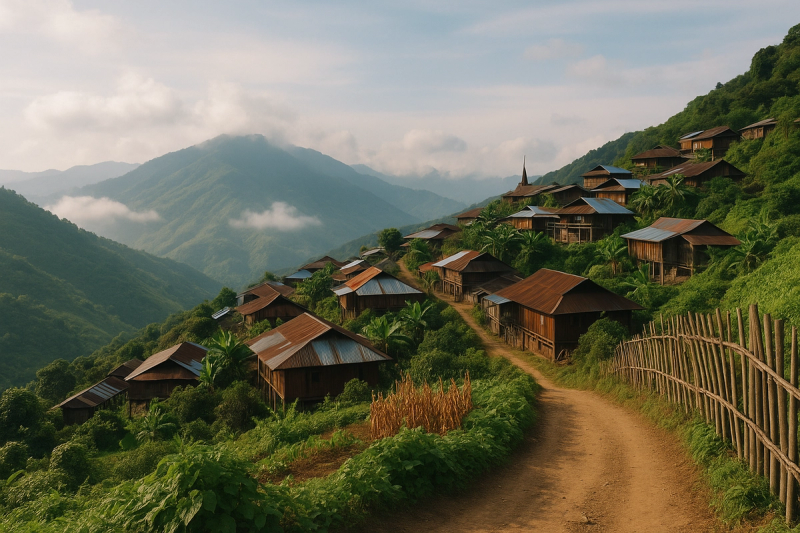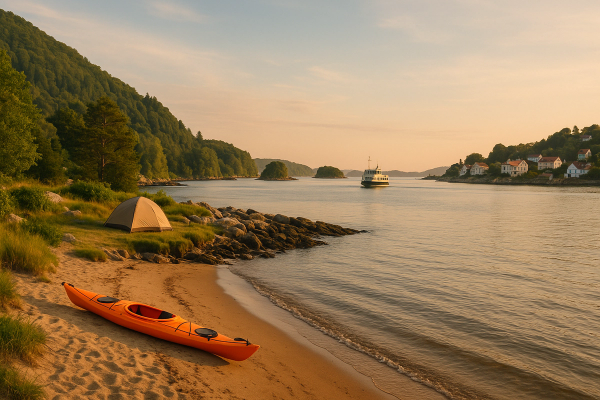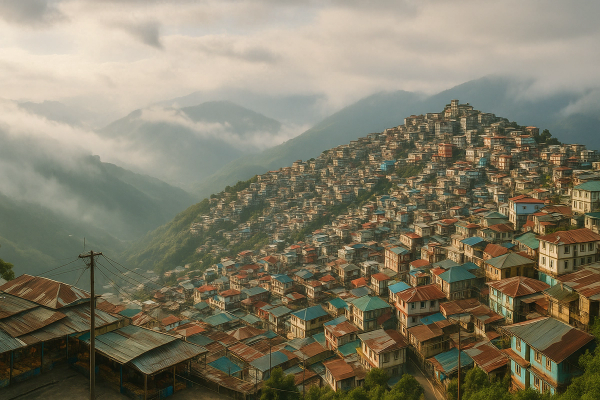Longwa Village Travel Guide: Indo-Myanmar Border, Nagaland — real talk, real tips, and a little bit of magic#
Um, so… Longwa. If you've heard that crazy story about a village chief whose house literally sits on both sides of the India–Myanmar border, that's not clickbait. It's true. And honestly, standing there with one foot in India, one foot in Myanmar, while the smoky smell of Naga kitchens drifts around and elders chat in soft Konyak voices—man, it hits different. I went recently, did a proper trip up to Mon district in Nagaland, and I’m still, like, half there in my head. It’s remote, it’s raw, it’s beautiful in a way that’s not Instagram-pretty, more like earth-and-wood kind of honest beauty.¶
Where the border literally cuts through someone’s home#
Longwa is in Mon district, northern Nagaland, at the very edge where India touches Myanmar. The iconic Angh’s house—Angh is the village chief—is split by the international boundary. You’ll hear folks joke, “Tea in India, lunch in Myanmar.” It’s kinda true. You can step across inside the village without any immigration drama, but it’s not like you can wander off down some road into Myanmar. Don’t do that. There are Border Security guys around, and locals know where the invisible line runs. Respect it. The whole vibe is strangely calm, actually, like borders are paperwork but life keeps going—wood fires, football, drying chillies on verandahs, that sort of quiet scene.¶
- Distance-wise: Mon town to Longwa is roughly 40–45 km, but it takes 2–3 hours with halts, potholes, and those “is this a road or a suggestion?” patches
- Nearest big airport is Dibrugarh (Assam). Jorhat also works. Dimapur is doable too but the route’s longer
- Road conditions: mixed. Some smooth stretches, then sudden rough gravel. During monsoon it can get honestly nasty
How to reach (without wanting to throw your phone into the valley)#
I came in from Assam. It’s the most common way. Dibrugarh to Sonari (Assam), then you head towards Mon town. From Mon, you get local shared sumos or hire a local car up to Longwa. If you’re a biker—this route is trendy right now—people from Guwahati and even Kolkata ride in. But if you’re not used to northeast hill roads, be chill, don’t try to be a hero on blind curves. Also, don’t rely on Google Maps blindly. It’ll sometimes draw lines through roads that are, well, theoretical.¶
- Option 1: Fly to Dibrugarh, take a car to Mon (6–8 hours depending on stops), overnight in Mon, next morning head to Longwa
- Option 2: Fly to Jorhat, drive via Sonari, same plan as above, just a different airport base
- Option 3: From Dimapur, it’s longer, but some folks club Kohima or Mokokchung, then loop up to Mon—this is more of a long circuit trip
From Mon town, shared sumos usually go early morning. If you’re more of the relaxed kind, hire a local taxi (rates vary, but expect around ₹2500–₹3500 return if you’re bargaining right and not peak season). Shared sumos can be around ₹300–₹500 per seat depending on demand, your face, your luck. Book a day before if possible, or ask your homestay/guest house guy to arrange. They’ll do it faster than you will, trust me.¶
Permits, safety, and the stuff no one tells you till you reach#
Okay, permits first. For Indian citizens, Inner Line Permit (ILP) is mandatory to enter Nagaland. You can apply online now—super handy—cost is a few hundred rupees, and choose Mon district if that’s your plan. Foreign nationals typically don’t need the old-school Restricted Area Permit anymore, but must register with the nearest police station after entry and carry ID everywhere. That’s current practice as of late 2024 and rolling into 2025, but rules change sometimes—check Nagaland Tourism’s site or call the DC office in Mon if you wanna be extra sure.¶
Safety-wise, Mon district is peaceful most days, but it’s a border region with a complex history, so just be sensible. Don’t roam off-track, don’t cross the border beyond the village limits, don’t photograph security posts, and please please don’t fly a drone. Drones at border zones are a strict no. Also, if you hear gunshots—calm down—it’s usually hunting or festival cannons in season, not a war. Go with a local guide if you plan to explore smaller hamlets; your experience will be 10x better and safer.¶
Where to stay (and how much will you spend)#
In Longwa itself, there are family-run homestays—this is the best way to experience the village. Rooms are simple but cozy, lots of wood, warm blankets, a little smoky aroma clinging to everything (I weirdly loved that). Price ranges are usually ₹1200–₹2000 per person per night including two meals. Tea and snacks extra, or the aunty will just push chai into your hands anyway and refuse money. Electricity can cut out a bit in the evenings. Hot water—ask nicely, be patient; some places have buckets with hot water. WiFi? Lol, no. Mobile internet? Patchy. BSNL and Jio worked on and off for me, Airtel was moody. Carry cash; there’s no ATM in Longwa, only in Mon town.¶
- Mon town stay ideas: a couple of hotels and guest houses in the ₹1000–₹3000 range. Not luxury, but comfortable enough with parking, reliable power, better mobile signal
- In Longwa: book homestays via Nagaland Tourism contacts, local guides, or simply ask around in Mon. Word-of-mouth works. Since festival season gets busy, pre-book if you’re planning early April
Food… oh man, the food#
Naga food is bold and beautiful. Smoked pork is the headline act—served with bamboo shoot, sometimes with axone (fermented soybean) that has this funky aroma you’ll either adore or deeply question. Sticky rice, boiled greens, humble vegetable stews, raja mircha (Bhut Jolokia) chutneys that can make you reconsider your life choices. If you’re vegetarian, don’t worry: you’ll still eat well—lots of greens, stir-fried seasonal stuff, tempered with ginger and naga garlic. Try local tea too—it’s simple, strong, comforting. Some families offer rice beer (zutho–style or local variants). Drink responsibly, be respectful—don’t push for alcohol if they say no. Simple etiquette goes miles.¶
Best months to visit (and when the roads bite back)#
Go October to April. That’s the sweet spot. Skies are clearer, evenings are crisp, and mornings glow. Winter nights can be cold—layer up, carry a light down jacket, thermal if you catch a windy night. April is special—Aoleang Festival, the Konyak New Year celebration, spreads across the first week. During monsoon (May to September), it’s lush and beautiful, sure, but the roads can be a pain. Landslides, slush, endless potholes. Unless you love that adventure, avoid peak monsoon. Also, leeches in rainy months—salt sachets or Dettol helps if you end up trekking around paddy fields and forest edges.¶
What to see and do (not just the border photo, haan)#
Longwa isn’t a box-ticking kind of place. It’s vibes and slow walks. Start with the Angh’s house. It’s big, old, dignified. Ask your guide or homestay host to introduce you properly—don’t just march in. You’ll see wood carvings, old skull motifs (most are symbolic now, not what you think), and stories of the past. People here belong to the Konyak tribe, once famous for headhunting—yep—but that’s long gone. Many elders have face tattoos and big bead necklaces. Ask permission before photos. Wander around the morungs (traditional youth dorms), check out the old log drums. The morning light in Longwa is magic—soft white mist lifting, kids running to school, hens gossiping, and hills stretching into Myanmar like giant sleeping cats.¶
- Do: Sunrise walks and slow conversations with elders. They’ll tell you stories about hunting, forests, and festivals that no blog can capture
- Do: Sit on the Angh’s verandah (if permitted). One step India, the next step Myanmar, and you’re sipping tea like a border diplomat
- Do: Hike short village trails. There’s a viewpoint above the houses where you see layered hills fading blue into… further blue
- Do: Buy local crafts—beaded necklaces, wooden masks, small carvings. Don’t bargain too hard. Put money right into the maker’s hands if you can
- Don’t: Try to cross into Myanmar beyond the village area. Don’t. Just don’t. It’s not a tourist border crossing
Lesser-known stops around Mon district (if you have time)#
If you’re making this a short expedition, fine—Longwa alone is worth it. But if you have an extra day or two, consider Shangnyu village. It’s known for its massive monoliths and wood carvings—there’s a story-laden heritage vibe there. Chui village also pops up in folks’ recommendations—old architecture, calm lanes, more Konyak culture. Both are closer to Mon town than Longwa, so you can club them on the way back. Get a local guide who knows the routes and who to talk to, it makes navigation and introductions much smoother.¶
Latest travel updates and general caution vibes#
There’s been a bit of a spike in people coming up here for that “border selfie” trend. It’s fine to take photos, but be mindful—avoid shooting any security infrastructure, patrols, or border markers. Also, drones are a big no in border zones (I’ll say it again because people still try). Occasionally, you might hear about road blockades or village-level events—just keep flexible. Ask in Mon town about weather and road conditions for the day. ILP checks do happen randomly—keep soft copies and a print if possible. As for health stuff: carry a basic first-aid kit, motion sickness tablets (ghats are twisty), and some ORS. There’s a small health centre in Mon and basic medical access, but don’t expect a metro hospital up here.¶
Costs and budgeting (keeping it real)#
If you’re careful with money, a Longwa–Mon trip can be done around ₹2000–₹3000 per person per day (excluding flights). Homestay all-in—with meals—usually eats ₹1200–₹2000. Local transport and guide might add ₹800–₹1500 per day depending on how much you’re roaming. Buying crafts, chai breaks, festival contributions—add a buffer. Fuel for bikers is available in Mon town; keep extra if you’re heading deeper. Cash only for most transactions up in the villages. ATMs are in Mon—try to withdraw there because sometimes the machine is like “yeh service abhi uplabdh nahi hai.”¶
Connectivity, money, and practical stuff#
Network: Jio and BSNL are your best bets in Mon. In Longwa, signal comes and goes. Airtel was flaky for me. Download offline maps, keep phone numbers written down. Power cuts happen—carry a power bank. If your charger brick is heavy, plug it before dinner and don’t expect to juice up after midnight. Cash: withdraw in Mon. Cards will mostly not work. If you must do UPI, pray to the network gods and keep patience. Also carry warm layers, rain jacket if it’s pre-monsoon, sturdy shoes. Sunscreen too, even in winter the sun peeks and ambushes you. Oh and yeah, please don’t litter—locals hate seeing plastic mess. Take your wrappers back with you.¶
Aoleang Festival (if you time it right, you’ll go home a little different)#
Aoleang is the Konyak New Year and it happens in the first week of April. It’s not a single-day spectacle—more like a series of rituals, dances, community feasts, and house-to-house celebrations. Longwa and other Konyak villages come alive with traditional attire, beads, feathers, and those epic log drums. You’ll feel welcome but be respectful—ask before joining a dance or clicking portraits, carry small notes for contributions if you’re offered food. Homestays get packed during Aoleang—book ahead. If you’re into culture more than crowds, arrive early April, stay longer, don’t just parachute in for one afternoon.¶
Etiquette and a few unspoken rules#
Nagas are warm, but they’re private about certain things—like ancestral items, sacred spaces, and women’s areas of the house. Ask before entering, keep your footwear where they say, don’t point your camera at elders without clear consent. If someone says no, take it as absolute—no means no. Dress modestly—this isn’t the place for super loud fashion experiments. Alcohol—don’t go wild. Music—keep volumes low. Offer a small gift for hosts—fruits, bakery items from Mon town, or useful stuff like tea packets. Feels old-school, but it’s appreciated.¶
My own moment: the quiet verandah scene I can’t forget#
There was this evening—gold light, kids practicing football with a half-bald ball, some old aunties cutting bamboo shoots on the step—and I sat at the edge of the Angh’s verandah. Half of the house in India, half in Myanmar. A boy asked me where I’m from; I said “Assam side,” and he nodded like it’s basically next door. The fog rolled in from Myanmar and the hills blurred into one long shadow. A kettle hissed. A dog snored. It felt like standing in a doorway inside a doorway—border outside, a different kind of boundary in your heart, if that makes sense. Sometimes travel is like that, you know… you don’t even realize what you came looking for till you’re stuck at some little wooden railing thinking too much.¶
3-day plan that actually works (not too hectic, not too lazy)#
- Day 1: Fly into Dibrugarh or Jorhat, drive to Mon town. Check into a guest house. Get your ILP checked, pick up snacks, withdraw cash, and speak with a guide about your plan for tomorrow. Early dinner and rest
- Day 2: Start early for Longwa. Stop for chai at village teas, meet your homestay family. Visit the Angh’s house respectfully, walk the village trails, view point for sunset if weather is clear. Simple dinner—smoked pork or veggie plates—and stories by the fire
- Day 3: Slow morning tea, buy crafts, drop by another Konyak village like Shangnyu or Chui on the way back to Mon. Overnight in Mon or connect onward to Assam if you have a strong driver and good roads
Photography tips (aka how to not be that annoying tourist)#
Golden hours are gold for a reason. Mornings in Longwa—that pale mist—gives you depth on hills without harsh contrast. Ask before portraits, show the picture to elders after, let them laugh and approve it. No flash in dark interiors please—hurts eyes, ruins mood. For phone shooters, stabilize: lean on a wall, rest your elbows, use a tiny tripod if you have. Keep your camera safe from smoky kitchens—wipe lenses, don’t freak out about a little soot. And yes, last reminder, don’t fly drones. Not even for 2 minutes. At borders, you can get into serious trouble beyond just a reprimand.¶
Trending experiences and what locals actually prefer#
Right now, a lot of bikers and road-trip folks are discovering Mon–Longwa because it’s got that edge-of-the-map cred. Instagram reels with “India–Myanmar border” captions are everywhere. Locals are fine with visitors as long as there’s mutual respect. What they prefer: small groups, slow travel, buying directly from artisans, not treating sacred spots as props. What they don’t prefer: aggressive bargaining, drunk loud nights, snapping unconsented portraits of tattooed elders like it’s a zoo. Travel shifts a place—be the kind of shift that feels good.¶
If you’re traveling solo or with parents (because so many of you asked me this)#
Solo: totally doable. Stay in Mon first night, connect with a guide, and go. Night walks in the village—keep it short and light, carry a torch. Parents: yes, as long as they’re okay with basic stays and bumpy roads. The homestay folks are lovely with elders. Food can be customized—mild spice, simple dal-like versions. Medical: carry regular meds and BP/sugar stuff. Also sweater-jacket combos—nights can be chilly.¶
Responsible travel, because we’re guests here#
Carry your trash back, bring a bottle you can refill, skip single-use cutlery. Buy crafts from the maker, not just random middlemen. Don’t over-bargain—pay fair. Learn a few words—thank you, hello—in local language or at least in Nagamese. Respect the ILP and local customs. The more we do this right, the more welcome we’ll remain for years.¶
Quick FAQ that’ll save you a couple headaches#
- Do you need ILP? Yes, Indian citizens do. Online apply is easy. Print it.
- Can you cross into Myanmar? Inside the village boundary for that iconic step, yes. Beyond that, no, not allowed.
- Is there ATM in Longwa? No. Withdraw in Mon.
- Mobile network? Patchy. Jio/BSNL best chance.
- How many days? 2–3 days if you’re focused. More if you want to wander.
- Festival time? Aoleang in early April—book homestays ahead.¶
Final thoughts (with chai in hand)#
Longwa isn’t a checklist. It’s a place where the border feels less like a line and more like a story. You go for the hills, the wood smoke, those tattooed elders who smile and bless you with a few words, the slow tea. You’ll probably come back with muddy shoes and a lighter mind. If you want more travel stories and practical guides that don’t sound like brochures, I’ve been digging through posts on AllBlogs.in—pretty useful for planning the northeast in general. Bookmark it, carry cash, and don’t forget to breathe when that mist rolls in. Safe travels yaar.¶














